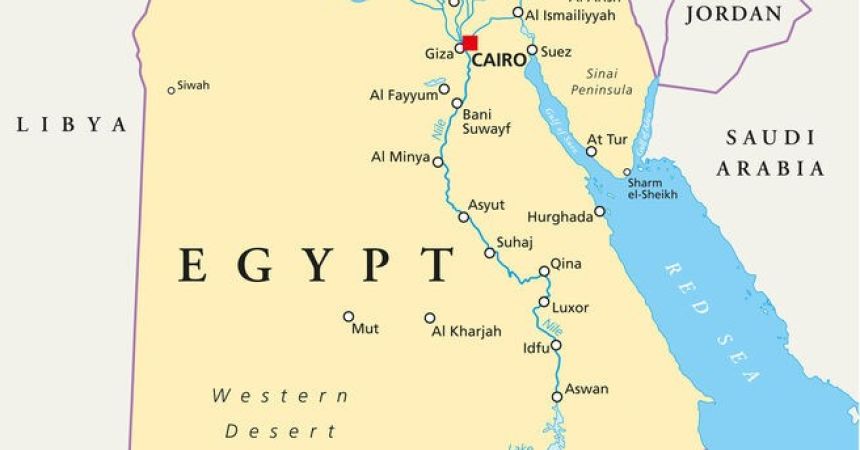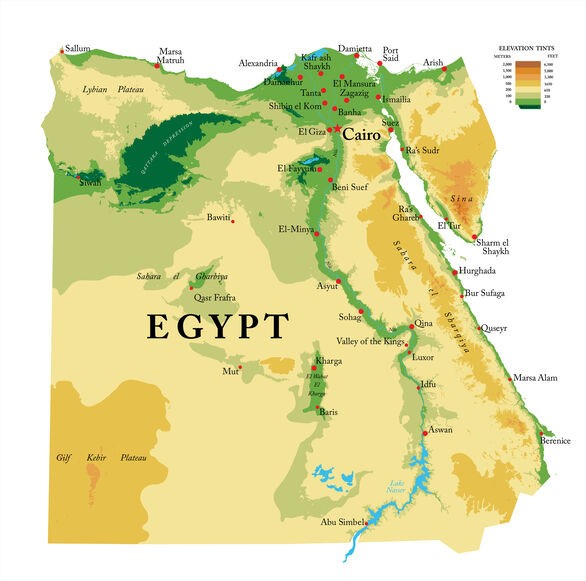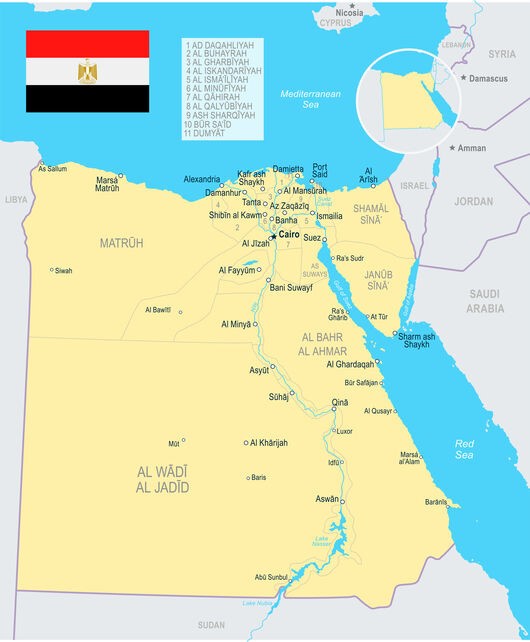
Map of Egypt – Detailed Country Overview
Introduction Egypt
Egypt, the land of pharaohs and pyramids, has captivated the world for centuries. Its map is a fascinating blend of deserts, fertile valleys, and a winding lifeline—the Nile River. Stretching across the northeastern corner of Africa and connecting to the Middle East, Egypt's geographical position has shaped its history and culture as a cradle of civilization.
This blog will explore Egypt, highlighting its diverse regions, historical landmarks, and cultural significance.
Geographical Overview of Egypt
Egypt covers an area of approximately 1,010,408 square kilometers, making it the 30th largest country in the world. It is bordered by:
- Libya to the west
- Sudan to the south
- Israel and the Gaza Strip to the northeast
Egypt’s northern coast meets the Mediterranean Sea, while its eastern side is bordered by the Red Sea. The Sinai Peninsula, part of Egypt, bridges Africa and Asia.
Key Features on the Map of Egypt
-
The Nile River
- The Nile flows from south to north, dividing Egypt into two distinct parts: the fertile Nile Valley and the vast deserts.
- The river’s annual floods historically sustained agriculture, earning Egypt the title “Gift of the Nile.”
-
Western Desert
- Covers two-thirds of Egypt’s land area.
- Features oases such as Siwa, Bahariya, and Farafra.
-
Eastern Desert
- Located between the Nile and the Red Sea.
- Rich in minerals and home to ancient mining sites.
-
Sinai Peninsula
- Connects Egypt to the Middle East.
- Known for its rugged mountains, including Mount Sinai, and coastal resorts like Sharm El-Sheikh.

-
Coastal Regions
- Northern coast: Mediterranean beaches like Alexandria and Marsa Matruh.
- Red Sea coast: Coral reefs and resorts like Hurghada and Marsa Alam.
Administrative Divisions of Egypt
Egypt is divided into 27 governorates, each with unique characteristics:
-
Cairo Governorate
- Capital: Cairo, the bustling heart of Egypt.
- Home to landmarks like the Egyptian Museum and Islamic Cairo.
-
Giza Governorate
- Famous for the Giza Pyramids and the Great Sphinx.
- Expands westward into the Western Desert.
-
Alexandria Governorate
- Coastal city known for its Greco-Roman heritage and the Bibliotheca Alexandrina.
-
Aswan Governorate
- Includes Aswan city, the Nubian villages, and the Aswan High Dam.
-
Luxor Governorate
- Often called the “world’s greatest open-air museum.”
- Features the Karnak Temple and Valley of the Kings.
-
South Sinai Governorate
- Focused on tourism, with resorts like Sharm El-Sheikh and Dahab.
Major Regions on the Map
-
Lower Egypt
- Located in the north, encompassing the Nile Delta.
- Includes Trip to Cairo and Alexandria, and the Mediterranean coast.
-
Upper Egypt
- Stretches from Cairo to Aswan in the south.
- Rich in historical sites, such as Luxor and Abu Simbel.
-
Nile Valley and Delta
- The most fertile and densely populated regions.
- Agricultural hub with crops like wheat and cotton.
-
Western and Eastern Deserts
- Sparsely populated but historically significant for mining and trade.
Historical Landmarks on the Map
-
Pyramids of Giza
- The only surviving Wonder of the Ancient World.
-
Luxor and Karnak Temples
- Testaments to Egypt’s ancient grandeur.
-
Abu Simbel
- Colossal statues of Ramses II carved into rock.

-
Valley of the Kings
- Burial site of pharaohs, including Tutankhamun.
-
Aswan High Dam
- A modern marvel controlling the Nile’s flow.
-
Mount Sinai
- Revered in Christianity, Judaism, and Islam.
Natural Wonders on the Map
-
The Nile River
- The world’s longest river, supporting Egypt’s ancient and modern civilizations.
-
Red Sea Coral Reefs
- Renowned for vibrant marine biodiversity.
-
White Desert
- Unique chalk formations shaped by wind erosion.
-
Siwa Oasis
- Known for its springs, olive groves, and ancient ruins.
Exploring Egypt Through Travel Maps
-
Cultural Routes
- Follow the Nile to explore temples and tombs.
- Discover Islamic Cairo’s mosques and bazaars.
-
Nature Trails
- Hike Mount Sinai or dive in the Red Sea.
- Visit the Western Desert’s oases.
-
Modern Cities
- Navigate Cairo’s vibrant neighborhoods or Alexandria’s Mediterranean charm.
Tips for Navigating Egypt’s Map
- Understand Distances: Egypt is vast; domestic flights or long drives are common.
- Urban vs. Rural Areas: Maps help differentiate bustling cities from remote deserts.
- Cultural Awareness: Mark locations for traditional markets and local festivals.
Cairo Adventures: Pyramids, Markets, and More
The map of Egypt is not just a geographical tool but a gateway to understanding the country’s soul. From the timeless Nile to the Red Seua’s shimmering coasts, every corner tells a story of resilience and grandeur. Whether you're exploring ancient wonders or modern cities, the map of Egypt is your key to uncovering its mysteries and marvels.



